Introduction
"Ham: a poor operator. A 'plug.'"
That's the definition of the word given in G. M. Dodge's The Telegraph Instructor even before radio. The definition has never changed in wire telegraphy. The first wireless operators were landline telegraphers who left their offices to go to sea or to man the coastal stations. They brought with them their language and much of the tradition of their older profession.
In those early days, spark was king and every station occupied the same wavelength-or, more accurately perhaps, every station occupied the whole spectrum with its broad spark signal. Government stations, ships, coastal stations and the increasingly numerous amateur operators all competed for time and signal supremacy in each other's receivers. Many of the amateur stations were very powerful. Two amateurs, working each other across town, could effectively jam all the other operations in the area. When this happened, frustrated commercial operators would call the ship whose weaker signals had been blotted out by amateurs and say "SRI OM THOSE #&$!@ HAMS ARE JAMMING YOU."
Amateurs, possibly unfamiliar with the real meaning of the term, picked it up and applied it to themselves in true "Yankee Doodle" fashion and wore it with pride. As the years advanced, the original meaning has completely disappeared.
The Q Code came into being internationally in 1912 to overcome the language problems involved in communications by radio among ships and shore stations of all countries. The original list of 50 adopted by international agreement in London contain many which are still familiar to amateur operators-QRN, QRM, QSO, the traffic operator's QRK, QSY and QRV -are now well past the half-century mark in continuous usage. QSL still has the official 1912 definition despite the changed informal usages it is subjected to in amateur parlance.
APX6 And A Thin Dime
Ed Heyman was my High School buddy. He was a year ahead of me and he was one smart devil. In fact, we still correspond to one another, usually in the form of jokes.

A real live APX-6 UHF IFF radio!
Anyway, Ed finds out that we can buy a military surplus APX-6 IFF Identification Friend or Foe transceiver for a few bucks. Note: Must have been popular because you can buy the tech manuals today for $20). It was a popular American surplus item. It was a micro wave unit used at about 1,5 GHz in fighter aircraft, for listening to American radar and sending back an identification together with the radar echo, telling the radar operator it was a friend and not a foe on the screen.
Early frequencies in these sets were classified and the Radio Operator had to carry the set with him if no military guard facilities were available.
The cockpit of the F-86A had an AN/APX-6 IFF radar identification set. The IFF set was equipped with a destructor which was automatically activated by impact during a crash or which could be manually activated by the pilot in an emergency. This was intended to prevent the codes stored in the device from being compromised by capture by the enemy.
He took the and soldered a dime into the tuning cavity to bring it into the 23cm band which was then 1215MHz - 1300MHz. He then plate modulated the lighthouse tube oscillator to produce AM.
This was not a led-soldering job, this was silver-soldering. Took a lot of heat! Ed and I held a couple of 500 watt soldering irons on that cavity for quite a while.
Bicycle Mobile Was Good ExerciseBicycle Mobile - I was a Ham Radio Operator (licensed as WA6CJC). I can remember WA6EOA (Ed Heyman) and myself wanting to do something unique so we decided to take our radio mobile. Today that would be no biggie but almost 50 years ago required muscle as well as skill! We were too young to drive so bicycle mobiling was the next best thing!
Below is me in my youth. What you do NOT see is bike #2 conducted by my good friend Ed. It had a car battery strapped to it and Ed had his fingers crossed hoping it would not fall off and spew battery acid all over everything. Including us!
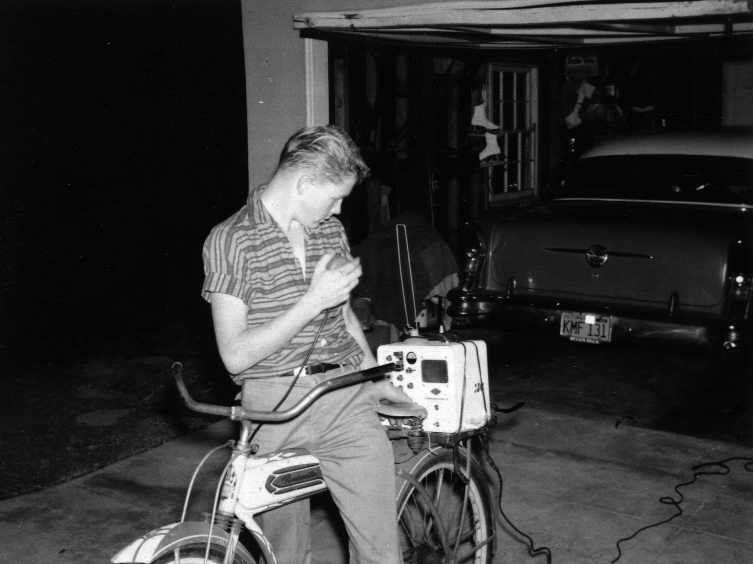
Your truly sitting on my trusty old bike tuning the Gonset for maximum smoke! See the cable behind the bike? It was connected to Ed's bike that contained the large lead-acid car battery! That's a 1955 Buick in the garage at Ed's house!
Ed strapped his Gonset Communicator on the back of his bike, I found a 12 volt car battery and strapped it to the back of mine! We used armored house cable between the two bikes to carry the power and voila'. . . bicycle mobile!
Why two bikes?? Remember this was in the last 1950's and the Gonset was 20+ pounds and the battery was about 30!. . . We needed two bikes! I'd sure like to hear from WA6FOS ("Moose" - Founder Of Stalingrad), WA6EOB (Bob Fairfield), and WA6DSD (Name escapes me!).... it's been 50 years guys!!
Flash!!! Bob Fairfield, Ed Heyman and I met in June 2000 at Hamilton High School... Bob retired as a Colonel in the US Army Infantry! Now a lawyer in LA!
Two Meters And The Repeater - We used the 144-148 MHz "2 meter" band. I remember we used the repeater on Mt. Lee.... I can't remember the call sign now but they were quite excited when we signed WA6EOA/M (Bicycle Mobile).
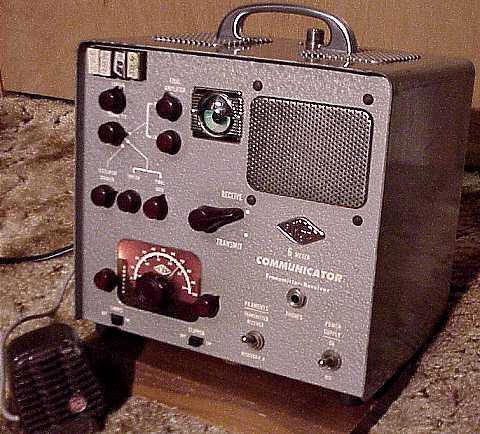
This was a six volt unit and it generated power using a "vibrator" which chopped
the DC into AC-like electric. Noisy, hot, and the eye was always watching you!
The trusty Gonset Communicator II... complete with tuning eye and mobile microphone!
But We Needed Six Volts! - Necessity is the mother of invention.. I remember Ed had a knack for being able to drive a nail into a battery at the correct location in order to get 6 volts... what the old Gonset needed! Of course we often had to stop and drive the nail back into the battery core.

The steel cable was pretty well worn after a few trip around the neighborhood. It used to make sparks as it was drug over the concrete streets. Must have been beautiful from behind!
Oops - We did pretty well riding up and down the hills in the back of Hamilton High School... I think the name of the place was Cheviot Hills... And there were hills! Ed and I traded off driving the bike with the rig. I do not know to this day how were rode the bike, talked, kept from killing ourselves since were tied together by 30 feet or armored house cabling, and laughed ourselves silly.
California Killly WobbleYou do NOT have to ask! I will tell you. A KillyWobble is a kilowatt (1000 watts). In our youth we called our California Kilowatt amplifier a KillyWobble. Now I have been out of Ham Radio quite a while so admitting to doing something wrong should not land me in jail but yes, I push the limit. In 1968 I built a real California Kilowatt.
It started with two parallel 4-1000A tubes. The 4-1000A is intended for use as an amplifier, oscillator, or modulator and is capable of efficient operation well into the VHF range. Cooling of the tube is accomplished by radiation from the plate and by circulation of forced-air through the base and around the envelope. Cooling can be simplified through the use of a SK-510 Air-System Socket and its accompanying glass chimney.
Tubes alone weighed in a 1.5 pounds each and to light the Thoriated Tungsten filaments took 7.5 volts
21.3 amperes each!
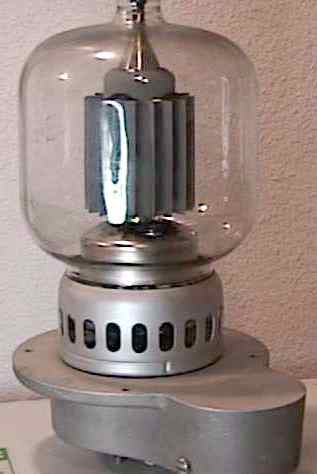
I used to make these tube glow bright red when
transmitting and we had two of them in the
big linear amplifier!
The power supply was a series of 572's mercury-vapor rectifiers which were used to provide me about 8,000 volts DC on the plates of the 4-1000A's. The 872's had to be warmed up for 10 minutes and then I would apply the voltage in three steps. 3000 volts for a few minutes so as to charge the capacitors, and 6000 for normal operations and them finally go-get'um at 8500 volts!
Pole pigs are specifically made to distribute electric power to places where it is needed. Distribution transformers (popularly called pole pigs) are what feeds power to your house. Look up at the power lines in any residential area, and see them for yourself. They're big white cans, and they drop 3 heavy wires down into the main breaker box of every house on your street, county, city, and country! These transformers are really cool in several ways. Here's the list:
- They're big! They can supply LOTS of power to whatever device you need it for.
- They're high voltage! They range from 2,400 volts to over 30,000 volts.
- It's easy to turn 'em around backwards and stick them in the wall socket!
I could hold the key down and put out 4KW all day. When on SSB, it would operate with 8500-9000 on the plate and the current would run upwards of an amp and a quarter.
Yep, I was pushing it but the whole thing was cooled with dual forced air fans taken from a home heating/cooling system. The air blown through the tube sockets/covers was nearly extreme... I could not put anything on the top of the cabinet as it would be blown off immediately!
Those where the days... Oh, yeah... I forgot. I did on many occasions set the key down and went into the backyard caring a fluorescent tube which lit up in my hands!
Transmitter Hunts
OK, you are up to speed! Ed and I needed a ride so I put my little mind together and began telling Judy about "T-Hunts". Judy was quite attractive I think. No, I did not know because she was a girl and I was a geek. She did have one significantly redeeming value, se could drive and she had a car! Judy worked in the dime store and I thought we was great. But alas, she was not within my reach as she was elderly... May even 18.
She decides to join us one Saturday evening on a T-Hunt and off we go. I told here to drive by my house so Ed Heyman and I could add the antennas to the car... "Antennas?" she replied. I said "Don't worry". So here I am attaching the antenna to the car so we can turn the antenna and determine which direction to drive in until we measure again! Ed made this little adaptor that clamped into the window.
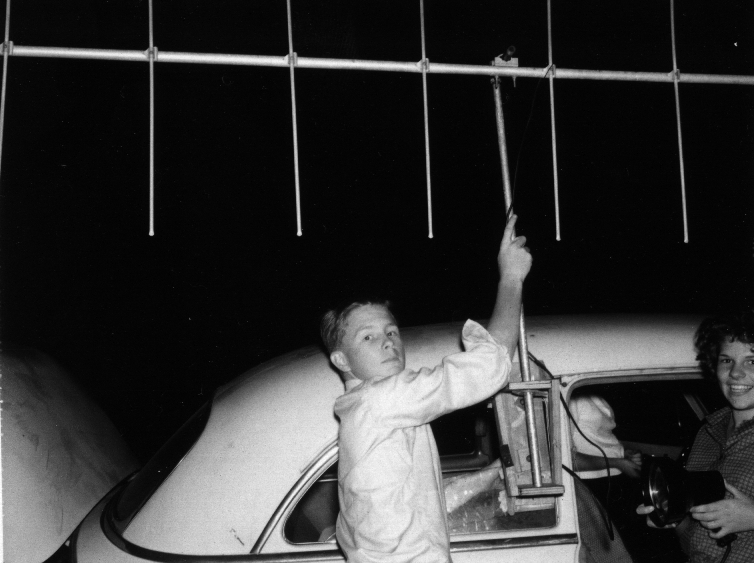
See the adapter we built for the back window. It allowed the pole to rotate. It was a little difficult to use when the car was going over 25 miles an hour!
So here is what happens. At 8:00 PM, the hidden transmitted stars going on 145.8. They have to identify every 10 minutes but they cannot move more that 100 feet from the starting place. We have no idea where they are so we start form home. Judy and the other girl (who I do no remember) do the driving and reading of the map. Ed and I are in the back seat with Ed operating two systems... One that listens to the hidden signal and talks to me as I turn the antenna. He talks me into pointing the antenna toward the highest meter reading. Ed also talks to others who are looking for it to triangulate!
Judy drives and says "Do a 180 turn here in the middle of the street???". The four of use laugh three hours way while driving all over town.
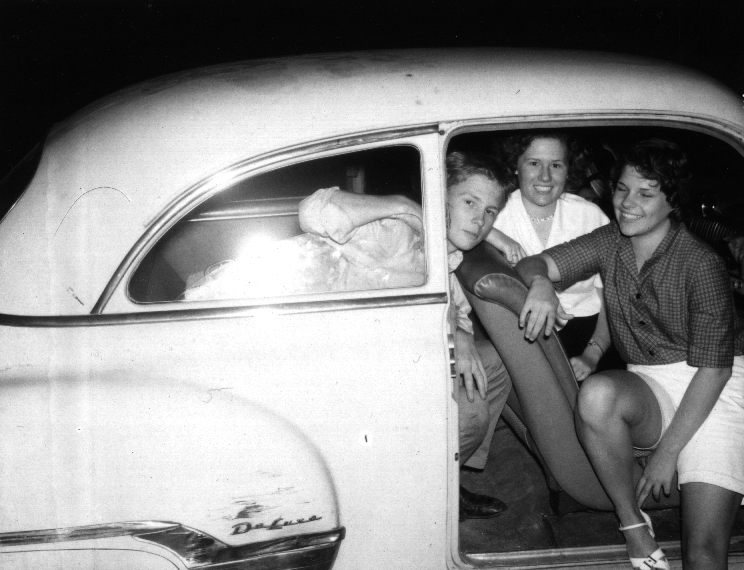
Ed took the pictures and Paul got the girls. Judy is the girl in white. I believe they were going to college at the time.
I don't know whatever happen to Judy and her friend but we did several transmitter hunts and a team of four. At 11:00 PM, the transmitter is pulled off the air and those who did not find it are called in and we all go to a drive in for refreshments. No one drank booze in those days so we usually ended up at a drive-in like Bob's.
We finally figured out why the girls like the T-Hunts (guess it did not take too much figuring'). It was the boys in the T-Hunt who were more their age. Once we got to the Bob's, Ed and I were dropped like the nerds we were and I guess we were traded in for bigger nerds!
Those were the days!I went to school with... A transistor radio! 6th grade and I had one... the first a lot of kids and teachers had ever really seen. It was a Zenith "hand-wired" set. Seven transistors (which plug into little sockets). Even had a nice leather case with earphone pouch on the back.
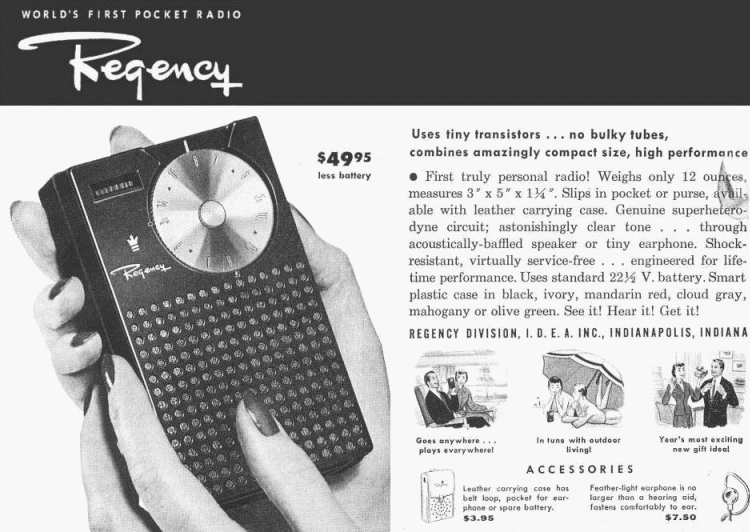
It may surprise you to know that the worlds first transistor radio was not Japanese, it was designed and manufactured in the United States by I.D.E.A. in Indiana. The transistors chips had been invented just 7 years earlier in 1947 and was just perfect for small radio design. The Regency opened the doors for others to follow, which they did in vast numbers. The Regency TR1 was first launched in black, red, gray and ivory, with deluxe finishes added for the Christmas 1955 season, pearl white, lavender, pink, lime and meridian blue. The TR1 measured just 13x8x3 cm, in the US it sold for $49.95 and $54.95 for the deluxe finish.
The first model was Texas Instrument Regency TR1, the left most model displayed above near other competitors, a portable radio 12 cm high (5") using four germanium transistors. Quickly sold out it was no more manufactured but another Japanese company, Tokyo Tsushin Kogyo sold a new model TR-55 that entered the US and European markets in Spring 1955.
Installing Ham Radio Antennas Was My Livelihood For YearsI got into ham radio in the mid 1950s and ended up working at Henry Radio through High School. hey would sell antennas and one of their employees would contract separately to install the larger systems. is name was Bert Chappell. He was a wild Englishman was quirky but an all around good guy. He drive a 1958 PINK Buick station wagon. I remember that thing because it was so awful to be seen in since I was in high school. It also has a bad habit of running out of water so Bert would carry a 5 gallon jog of water to fill the radiator.
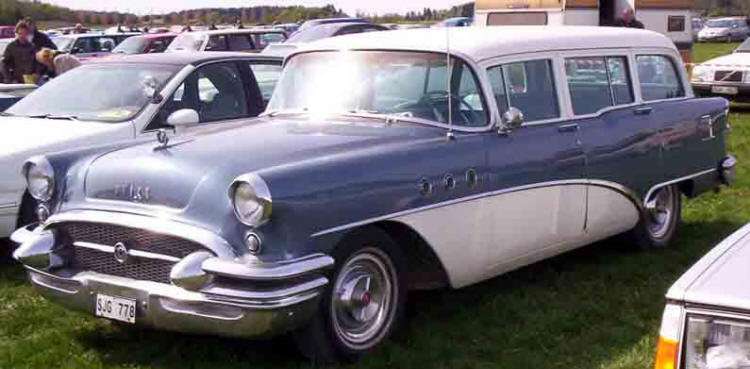
You would be amazed at what was hauled in this car. We had a steel tower on it one day that weighed over 1,200 pounds! To get it off the top, we tied a cable to a fire plug and drove away!
So Bert would arrange these jobs and as I now recall, Bert was quite fair with me even though I was a kid. He liked me because I was pretty strong for my age and I inherited my Dad's ability to solve problems. Get this, I mad $100/day in 1959. That would often be $10/hour. This was hard work but it paid well. Here are two example I remember well.
Twenty Floors Up - This fellow had a real elaborate suite on the 12th floor of a twenty floor building. He had money as the suite was in Wilshire Blvd in LA. He got into ham radio and wanted a rotatable antenna placed on top of the air-conditioning/elevator machinery room and cables/control wires run to this apartment. We worked two full days on this one. We first put up a 20 foot steel tower on the top of the building (that means on the top of the steel shed on the top of the building). hen we carried and pulled by rope the antenna from the round floor. This was a yagi like the one shown below:

This is a yagi antenna good for the 10-15-20 meter bands. I had one 70 feet in the sky right over my bedroom as a kid!
Once the pieces were up-top, we assembled them and then proceeded to climb our tower (now we are 22 stories up) and drag this antenna up the tower, over our heads, and attach it to the rotator assembly.
Done? Not, not yet. We then had to run he rotator controls and antenna coax down 12 flights of stairs carefully attaching the cables so they could not be seen. This meant drilling cable attachments every two feet into steel stairwells. Finally upon getting to his suite, we had to enter the ceiling and crawl from the stairway to his ham radio room.
It worked, but what a job!
K6CXI Field Day Guaranteed Mosquitoes And FunField Day was designed to test operators' abilities to set up and operate portable stations under emergency conditions such as the loss of electricity. Not only is this event a serious test of skill, for many clubs and groups it's a social occasion too.
During the weekend, participants try to contact as many other participating Field Day stations as possible.
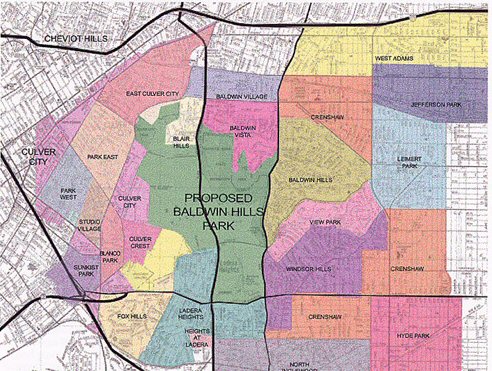
Approximately 35,000 Amateur Radio operators participated in last year's Field Day. The first Field Day was held in 1933.
During emergencies and disasters such as tornados, earthquakes and fires, ham radio operators regularly volunteer to support governmental and non-governmental organizations such as the American Red Cross and The Salvation Army, with communications assistance and other help. But the need for their services doesn't stop there. In September 2003, ARRL was awarded a second year of federal funding for emergency communications training, emphasizing support for ham radio's role in homeland defense and its vital contributions to localities.
Today there are nearly 700,000 Amateur Radio operators in the United States and more than 2.5 million worldwide.
Memories From A FriendThis is a note from a friend... a friend of 40+ years ago... a friend who describes himself a "minor character out of your past"... yet he is NOT minor, but someone who I perhaps influenced... someone who took an interest in something I was doing and modified his direction in life because of me... Wow! What a feeling! Thanks Clint for such a wonderful note from our past! Makes being a those days a "nerd" worth while!Oh... My Dad was Paul and therefore I was known by my middle name, David (Dave) by my friends and family
A Note From An Old Friend
Dear Dave (or Paul):
I only knew you as Dave in 1959. I am a very minor, minor character out of your past. But, I have really enjoyed your web pages....and I am very excited to know that Mr. Brown is still on this side of eternity. Thanks for finding him! I went back to Hamilton High in 1987 to find out about Mr. Brown and they coolly ordered me to leave the office...not very friendly...drugs have changed the attitude of educators. In their eyes I was some kind of possible danger to humanity. All visitors are unwelcome.
Anyway...I wanted to reminisce with you about the famous K6CXI Test Field Day...not held on the real field day. Anyway, do you remember when Hughes Aircraft invited Mr. Brown and the whole K6CXI Hamilton High Ham club to come up to Hughes' Baldwin Hills radio test site shack, overlooking Culver City and West L.A.? You were there running some portable equipment. And you invited me to come along, even though I was only a junior high kid, at the time...but very interested in radio.
Well, anyway, Hughes had said to Mr. Brown..."you know.. you guys are welcome to use the equipment in our building if you like"... Mr. Brown, being the smart man he was and knowing the Hughes equipment would possibly be a lot safer out of our reach, kindly waved-off the generous offer. Anyway, as the day progressed, and we were making all kinds of contacts somebody from Hughes came up and let us see inside the building. To our surprise there was a full Collins S-line, I believe, if my memory serves me correctly. Suddenly everyone kind of wondered if Mr. Brown had made the right decision. But, I know he was wise and that equipment stayed in it's pristine condition, out of our reach.
I often visited your shack and my eyes always fell out of my head in wonder. I was not a ham at that time...but later, because of your influence I became WB6BZV, WBzeroKXU, WB7NPT and finally KD7NK. Just last year I purposely let my Advanced ticket lapse. I too have become too interested in Computers and also...ham radio isn't what it used to be. I enjoyed the days of Heathkit,
Globe Scouts
, Hammerlund, S-Line and build it yourself. The bands just got too clogged up for my taste with angry people and poor taste. But I was involved for 38 years as a ham. My first receiver was an NC-300...I couldn't afford a
303
like my friend Dave Liles had...but the 300 was good enough.
I do owe you a big "thank you" for being such a hospitable young man and taking an interest in me. You were an unusual teenager even in that better era. Because of you I went on into Ham radio and almost became and electronics engineer, even did a stint at NASA as an engineering student trainee.
By the way...you won't probably remember me...but I was that annoying Herald Express (later the Herald Examiner) news boy who would park his bike outside your shack and sit mesmerized as you worked skip on 20 meter sideband, while my customers wandered through their yards looking under bushes for a paper that had not arrived but was parked at WA6CJC's shack.
After you moved away in 1961, I believe, I went on as the newsboy until 1962...and still remember pedaling my bike by your house and sadly missing all the fun I used to have stopping and watching you.
I remember when you had a
Gonset Communicator III
, or had borrowed one. You were on 20 with one hand and chewing the rag on W6MYK, the Mount Lee A.M. 2 meter repeater, with the other hand...oh, those were the days!!!
Did you ever get on the Venice bus and ride to downtown L.A. to "J.J. Glass" to look at ARC-5s and all the other World War II surplus radio treasures?? That was one of my favorite activities back when it was safe to go almost anywhere in L.A. on a sunny day. I sure loved walking the isles of J.J. Glass!! Or, if bus fare and time were a bit tighter...I would sneak over to Henry Radio to wander from one radio room to the next. If I was lucky somebody would be making a few contacts using that super 80 foot telephone pole with a tri-bander perched on top. And, if I was really lucky...and nobody was looking I might even become a dumpster diver and surf through the treasure trove of rejected resistors and capacitors in the metal
Henry Radio
electronic freebie can outside in the back next to the 80 foot telephone pole. Yes, those were the days!! To bad I didn't recognize it at the time!
And, I carried my
ARRL
General Class questions and answers everywhere I went. When I was bored I could always memorize another answer. Let's see, a triode has a grid, a plate and a cathode, GOT IT!
Then there was the two famous trips to Downtown L.A. to the scary F.C.C. office for the big test. Oh, I was downcast that first time when I flubbed the code. But, 30 days later, VICTORY!!!! At 15 years of age I walked out with my General Class license and no money for a rig...but at least I could call CQ in the shower and drive folks at home mad!
Clint Stetson (former
KD7NK
Sputnik Was Seen And Heard
History changed on October 4, 1957, when the Soviet Union successfully launched Sputnik I. The world's first artificial satellite was about the size of a basketball, weighed only 183 pounds, and took about 98 minutes to orbit the Earth on its elliptical path. That launch ushered in new political, military, technological, and scientific developments. While the Sputnik launch was a single event, it marked the start of the space age and the U.S.-U.S.S.R space race.
The story begins in 1952, when the International Council of Scientific Unions decided to establish July 1, 1957, to December 31, 1958, as the International Geophysical Year (IGY) because the scientists knew that the cycles of solar activity would be at a high point then. In October 1954, the council adopted a resolution calling for artificial satellites to be launched during the IGY to map the Earth's surface.
In July 1955, the White House announced plans to launch an Earth-orbiting satellite for the IGY and solicited proposals from various Government research agencies to undertake development. In September 1955, the Naval Research Laboratory's Vanguard proposal was chosen to represent the U.S. during the IGY.
The Sputnik launch changed everything. As a technical achievement, Sputnik caught the world's attention and the American public off-guard. Its size was more impressive than Vanguard's intended 3.5-pound payload. In addition, the public feared that the Soviets' ability to launch satellites also translated into the capability to launch ballistic missiles that could carry nuclear weapons from Europe to the U.S. Then the Soviets struck again; on November 3, Sputnik II was launched, carrying a much heavier payload, including a dog named Laika.
Immediately after the Sputnik I launch in October, the U.S. Defense Department responded to the political furor by approving funding for another U.S. satellite project. As a simultaneous alternative to Vanguard, Wernher von Braun and his Army Redstone Arsenal team began work on the Explorer project.
On January 31, 1958, the tide changed, when the United States successfully launched Explorer I. This satellite carried a small scientific payload that eventually discovered the magnetic radiation belts around the Earth, named after principal investigator James Van Allen. The Explorer program continued as a successful ongoing series of lightweight, scientifically useful spacecraft.
The Sputnik launch also led directly to the creation of National Aeronautics and Space Administration (NASA). In July 1958, Congress passed the National Aeronautics and Space Act (commonly called the "Space Act") , which created NASA as of October 1, 1958 from the National Advisory Committee for Aeronautics (NACA) and other government agencies.
Tap The Night AwayNope! Not the kind of tap you are thinking about. My greatest ham radio joy was using Morse code and a very small transmitter made from a 6AQ5. This little bugger was crystal controlled and used a 275 volt B+ line which I often got bitten by.
Tap-tap-tap I would go. CQ DX QRP. 2-3 watts of pure hope and often late into the night I would get a reply from around the world. I hung out around 14.090 megacycles so I would got get trampled by the kilowatt rigs of the high power folks.
I would often be up all night, mostly listening on my NC303 or 75A4 receivers and responding to the faintest of signals.
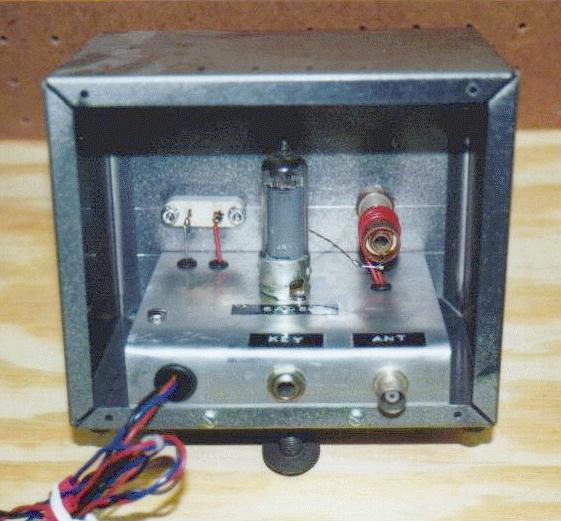
I put this little puppy to work! I had three crystals that I had to use to change my
transmitting frequency. No VFO in this little guy1 6AQ5 did all the work!
I often feel bad that kids today's can't feel the kind of excitement we felt. Today, one pulls out the cordless cell phone and taps a few buttons and one may talk anywhere in the world.
In yesteryear, we would stay up all night and listen through a big pair of cans (headphone) to the while noise and lightening strikes in the background for some little faint beep-bee- from a far away person and be ecstatic if we could exchange call-signs and S-Metes readings! Then we would wait for months for the QSL card to arrive in order to proclaim success.
Transmitter Hunts Kept Us Busy Saturday Nights"T-Hunts" mean Transmitter Hunts. This was a subculture to the Ham Radio gang and it involves a person hiding a transmitter in a specified area and everybody else trying to find it in a period of four hours!
Now remember this was in the 1950s/1960s where micro-miniaturization was in the realm of Popular Science. We still had vacuum tubes and car batteries. If you could get four hours out of a 6-vold lead acid battery with a Gonset Communicator II transmitting away, you were a miracle worker!
What was so much fun about it you ask? Well there were many aspects. Things like technology: who could design the smallest directional antenna? Driving skills: who could turn around on a dime, backup three blocks all at once, navigate an alleyway at night, and not loose the antenna hanging out the window? Social skills: Who has the prettiest date who isn't to inept that they talk over the hidden transmitter? Teambuilding: which team can communicate on another frequency and help a team member locate a transmitter WITHOUT being overheard?
The one event I remember is the time a couple hid the transmitter and battery inside a baby carriage (remember those??) on Hollywood Blvd and moved back and forth in front of the Graumens Chinese Theater for four hours! They were finally found about 11:45 after a wild ride up and down many streets in Hollywood.

These were our drivers! Yup, Ed Heyman and I were too young to drive but we had connections! Judy (the driver) worked at the dime store and when I explain what a "T-Hunt" was, she said "Let's go, I'll drive". We had a ball and Ed and I because real popular with the older guys... wonder why?
I wonder where Judy is these days as she is probably 70 by now.
Weather Balloons KillField Day circa 1957/1958 and we were on the top of the highest point in our area, the Baldwin Hills.
When Baldwin Hills was developed, a lot of the streets were given Spanish names maybe to honor the Mexican landowners who sold the property to real estate speculator Lucky Baldwin in the early 1900s, maybe to sucker the early Anglo buyers into thinking they were part of some exotic, early California past.

We used to go to the hills and ride or bikes, explore the old building, and even look at the Nike Base. The reservoir was on the top of the hills and it fed a lot of the surrounding area.
Anyway, ham radio Field Days require the equipment, generators, tents, and staff to go to the high spot in the surrounding area. That one specific Field Day one of the guys brought a weather balloon thinking that it would raise a long-wire antenna well into the sky to help our signal. So we tied a spool of copper-bronze antenna wire to it and off it went. The other end was tied to a E.F. Johnson Viking Ranger transmitter, known to be able to use almost anything for an antenna! All went well for a while until the balloon reached a good altitude and we discovered "static electricity" again.
That transmitter was so "hot" that we had to use gloves to tune the transmitter and run the bug (ham radio talk for Morse code key). Being brave, when it came to my turn to tickle the bug, I refused gloves for about 5 minutes and by them it just hurt to darned bad.
Wet And Slippery
In high school I needed money, who doesn't? I worked in a Ham Radio store and joined up with Bert Chappel. He was a crazy Englishman who drove a huge 1956 pink Buick station wagon! That car would go miles and then Burt would stop and pour water in the radiator, he was too cheap to have it fixed I guess.
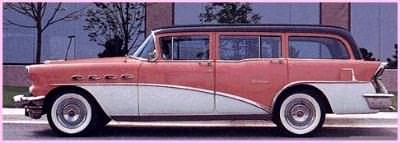
We joined forces and would put up antenna systems for fringe area TV viewers and large Ham Radio antennas. I have a bunch of stories to tell, here are a few:
Slipping off the roof - It was time for the big game ad the rich guy bought a new TV and wanted Burt to put up a forty foot pole with rotator on the top of this two story Pacific Palisades home. The date for the job came and it was raining. Burt, never to turn down a dollar, told me the job was on. I thought he was crazy but off we went. It took us the better part of a day to put together the fancy new antenna, assemble and checkout the rotator, and then push up a 10 foot sectioned telescopic mast. So here we are, both of us on ladders on the peak of a two story house in a rain storm pushing up 10 foot sections of a forty foot mast. Simple, nope! We had to guy it as we went and the whole shooting match would fall over. Finally, it is up. We are tired and it is time to clean up. I slipped and off I slide down the roof (imagine wet wooden shingles after a week of rain!) and over the size right into a small cactus plant. I was sixteen then so I got up and all was fine except for the blood everywhere. I was Ok until the next day and I learned about back aches.
On top of the world
Up and down the hill
In the athletic club
Climbing gear